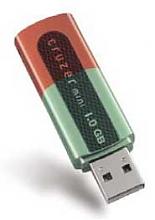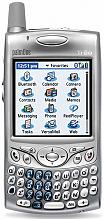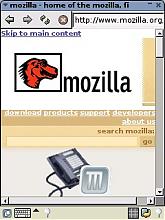Fri February 18 2005
 SanDisk BookLocker - flash drive for e-books SanDisk BookLocker - flash drive for e-books
|
|
10:33 AM by Alexander Turcic in Archive | Handhelds and Smartphones
SanDisk claims that the BookLocker offers "unparalleled safeguards" to protect publishers' content from being replicated. How does it work? BookLocker devices are divided into two distinct memory areas: An open zone for the student's files, and a secure zone, which is used to store copyrighted content. The secure zone cannot be accessed by the student or operating system. Content is stored on a trusted BootLocker server network using AES encryption. When the content is downloaded to a BookLocker device, it is encrypted with that device's unique hardware key. The server also keeps track of the number downloaded electronic textbooks. Publishers can get up to date reports on the number of electronic textbooks available and sold. When deployed at schools, school administrators and librarians can see how many books are in use and how many are available for lending to students. Unlike software only DRM solutions, BookLocker's patented security measures utilize both hardware and software elements to protect the publishers' IP. SanDisk is running several pilots at the University of Denver, College of Law. In fall 2003, a BookLocker pilot was launched with students for a Corporations Law course. The BookLocker devices were loaded with course materials such as textbooks, case studies and statutes. The next semester, another class was added to the pilot. This time, students were given laptops and BookLocker devices with textbooks for a Trial Advocacy course. In fall 2004 the third BookLocker pilot was launched with additional students in 2 courses – Torts and Lawyering Process. The BookLocker devices were distributed with textbooks from leading publishers such as Lexis Nexis and Aspen. My personal opinion: this is not really what we were looking for - another proprietary DRM solution to further alienate potential e-book customers. |
|
[ 5 replies ] |
 Maxpedia - Wikipedia mobile proxy Maxpedia - Wikipedia mobile proxy
|
|
10:12 AM by Alexander Turcic in Miscellaneous | Lounge Found this interesting link today: Maxipedia.org is a free proxy for mobile WAP access to Wikipedia. Simply type in wap.maxpedia.org into your phone browser and get access to the world's largest Encyclopedia. |
|
[ 3 replies ] |
 Exclusive: PalmGear & PocketGear Mobile and Feeds Exclusive: PalmGear & PocketGear Mobile and Feeds
|
|
09:09 AM by Alexander Turcic in Miscellaneous | Lounge
PalmGear & PocketGear Feeds PalmGear Updated Software: https://www.mobileread.com/feeds/pgupdated_rss20.xml If you don't know what RSS feeds are (or how to use them), make sure to visit our RSS section which has a good first overview. PalmGear & PocketGear Mobile PalmGear Updated Software: https://www.mobileread.com/avantgo/pgupdated_mobile.html Suggestions are always welcomed. |
|
[ 1 reply ] |
Thu February 17 2005
 More Information About PalmSources Future in Phones More Information About PalmSources Future in Phones
|
|
02:41 PM by Bob Russell in Archive | Handhelds and Smartphones
It seems that PalmSource has interest in Linux based PalmOS for more than just PDAs and smartphones. Your basic mobile phone of the future may look like something with PalmOS, even if the similarty is just on the surface. Apparently there's a difference between Americans and Asians regarding what kind of user interface people like. PalmSource has expertise in user interface design that would apply very well to mobile phones. It's an uphill battle against some pretty significant competition, but you never know! |
|
[ 1 reply ] |
Wed February 16 2005
 Yeti3D Pro optimized for Dell Axim X50v Yeti3D Pro optimized for Dell Axim X50v
|
|
09:09 AM by Colin Dunstan in Archive | Handhelds and Smartphones
Dell Axim X50v users can cheer up, because now there is also an Intel 2700-OpenGl ES optimized version available for download. The demo is a technical preview. As such, it is not complete (no sound, limited game logic and the like). It may do hideous things to your system such as delete files, randomly change your appointments and send rude emails to your mum. I doubt it, but you have been warned! Make sure to read the included readme.txt file first. |
|
[ 0 replies ] |
 KBattery 1.0.3 freeware battery gauge KBattery 1.0.3 freeware battery gauge
|
|
06:17 AM by Colin Dunstan in Archive | Handhelds and Smartphones KBattery is a tiny (19Kb) application that displays a battery meter and the memory/storage card status for WM2003 and WM2003SE PocketPC devices. I installed it and will probably keep it on my device! |
|
[ 0 replies ] |
 Windows Mobile tops PalmOS in 2004 (Gartner) Windows Mobile tops PalmOS in 2004 (Gartner)
|
|
04:47 AM by Colin Dunstan in Miscellaneous | Lounge According to preliminary data released this week by Gartner, worldwide PDA shipments increased 6.6 percent to 12.3 million in 2004 compared with 2003. According to the analyst firm, increased average selling prices drove worldwide PDA revenue to a record $4.3bn in 2004, a 16.7 per cent increase on the year before. In the fourth quarter of 2004, the average price of PDAs reached $353, up 9.4 per cent from 2003. "The PDA market has shifted from unconnected organisers overwhelmingly purchased by consumers to a market in which 44 per cent of the devices shipped in 2004 offered integrated wireless and/or wireless Lan connectivity," said Todd Kort, principal analyst at Gartner's Computing Platforms Worldwide group. The fourth quarter traditionally has seen large shipments of PalmOS devices, but Windows CE licensees have taken a substantial lead, and Research in Motion is poised to become the leading PDA vendor in 2005. Windows CE steadily gained share in the PDA operating system market, accounting for 37.7 per cent worldwide in 2003. In 2004, Windows CE became the top PDA operating system when it accounted for 43 per cent of shipments. Palm OS has slipped from 50 per cent in 2003 to 36.3 per cent in 2004. "Microsoft-based PDAs have gained favor mostly due to their affinity with the Windows PC market and Microsoft's ability to attract more than 30 licensees around the globe," Mr. Kort said. Additional information is available in the Gartner Alert RIM Sparked PDA Market to Grow 6.6 Percent in 2004. |
|
[ 0 replies ] |
 Mini-Mozilla project looking for Pocket PC developers Mini-Mozilla project looking for Pocket PC developers
|
|
04:34 AM by Colin Dunstan in Archive | Handhelds and Smartphones
Doug Turner, one of the Minimo project leaders, is now looking for people with expertise in Windows CE programming to help him working on a port for Windows CE devices:
You can contact Doug at dougt[at]meer[dot]net. |
|
[ 0 replies ] |


 Looks like SanDisk, flash memory data storage specialist, is planning to win a share of the e-book market with the introduction of its
Looks like SanDisk, flash memory data storage specialist, is planning to win a share of the e-book market with the introduction of its  I have great news for all (mobile) news junkies!
I have great news for all (mobile) news junkies! 

 Do you remember
Do you remember  Latest E-Books
Latest E-Books


